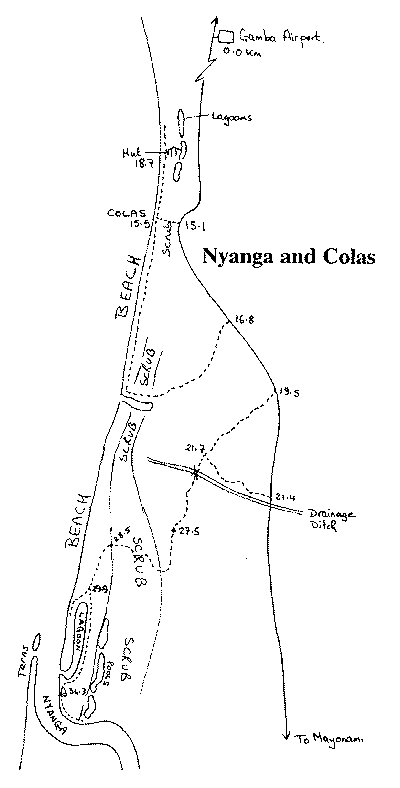Section 1 - Introduction, logistics, itinerary and general information.
Section 2 - Birding sites (part 1).
Section 3 - Birding sites (part 2).
Section 4 - Birding sites (part 3).
Section 5 - Annotated checklist with identification notes (non-passerines).
Section 6 - Annotated checklist with identification notes (passerines).
Birding Sites
Details are given for worthwhile birding sites throughout Gabon. Included for most, is a daily diary of how the area was worked, disasters which struck, hassles encountered, and how to avoid them. A 'c' denotes that the species is common or fairly so. An 'h' refers to species heard only.
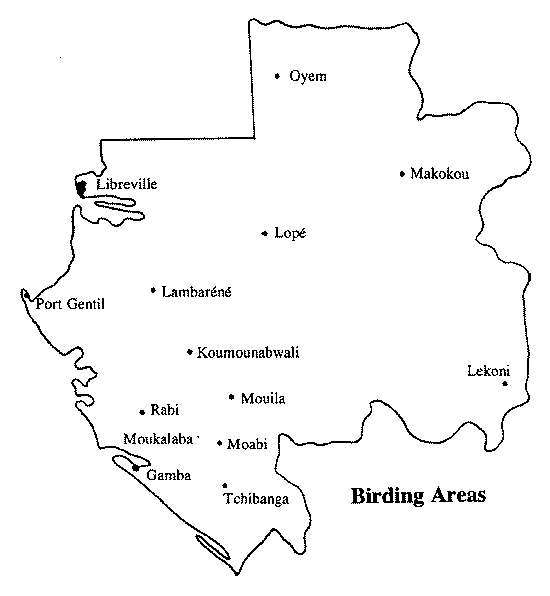
Gamba
Save for a few specimens collected by missionaries based at Sette Cama during the early part of this century (Malbrant and Maclatchy 1949), Gamba had never been studied ornithologically. Although the forest/savanna habitat differs little from much of the littoral of southern Gabon, five years of study have resulted in several species being best known, and most easily found, here. To date, more than 380 species are listed for the area.
By far the greatest attraction is the highly sought-after African River-Martin, thousands of which are breeding visitors between September and November. They nest in small colonies of 100-200 pairs in grassy plains, but are most often seen, and heard, in feeding flocks high overhead. Other highly localised species, fairly readily found are Black-headed Bee-eater, Red-tailed Palm-Thrush, and Loango Weaver. Other possibilities include White-backed Night-Heron, Vermiculated Fishing Owl, Sandy Scops Owl, Maned Owl, Pale-olive Greenbul and both Black Guineafowl and Plumed Guineafowl.
The Gamba community, set-up and maintained by the oil giant Shell, consists of an airport, production facilities, a few oil workers' camps and a local town of a few thousand Gabonese (nearly all of whom work for Shell). Gamba town, known locally as Plaine Trois has a few local shops and restaurants, but no accommodation. Unless you know one of the Shell employees it will be necessary to camp, though this is hardly a problem, as a few minutes' drive from the airport takes you to large grasslands and good forest.
Gamba is principally accessed by air from Libreville. Air Gabon flies Libreville-Port Gentil-Gamba return three times weekly. For those with more time, the only alternative is one of the bush-taxis from Tchibanga. These depart the market square almost daily at 07h00 and take six to eight hours to do the journey. Once in Gamba, a 4x4 is necessary, but not readily available. One local company, EGCA, hires 4x4 Toyotas and Suzukis to Shell. They will hire privately, but contact well in advance.
Four basic habitat types exist: coastal scrub, secondary growth, primary forest, and open grassland. Depending on time available all can be covered, though the major specialities are found in coastal scrub and primary forest. For some unknown reason, the grasslands are particularly species-poor, especially compared to those farther inland. Good forest is accessible via a series of tracks made by seismic exploration crews, selective logging operations, and local hunters. Below are listed the eight best areas which should produce many of the sought after species. The first two are essential. The starting point for most maps is the airport. All distances are in kilometres. Due to the volume of data, numbers of observations are not given for birds seen around Gamba. Instead, an indication of how commonly it occurs is given:
c - common or fairly so and likely to be seen on most visits.
o - occasional; maybe seen on half the visits.
r - rare or uncommon; unlikely to be seen.
Bracketed species require confirmation.
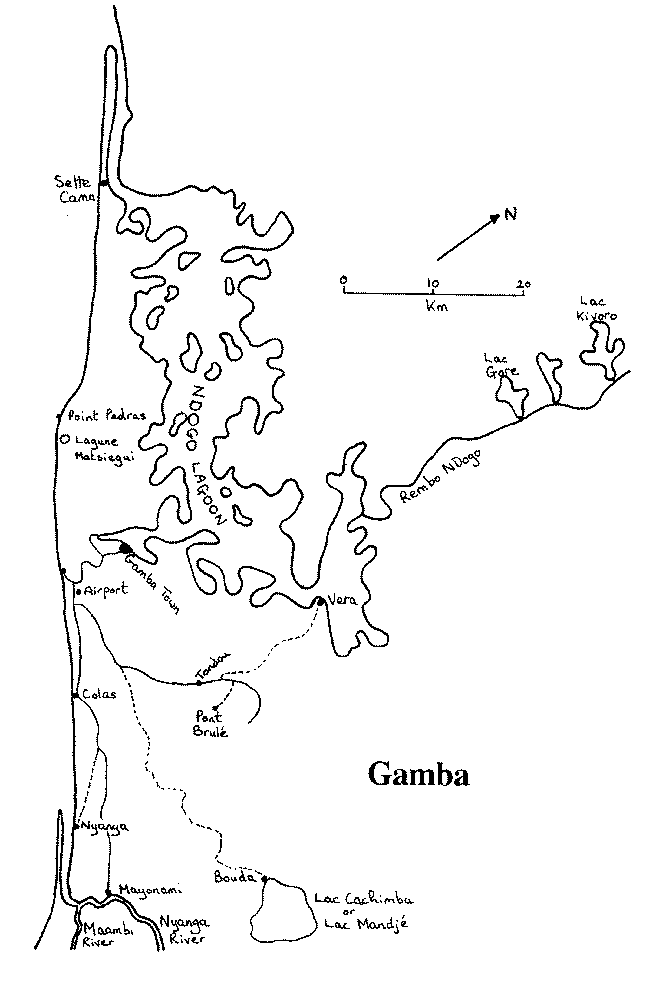
Gamba 1. Tondou and Pont Brulé Forests. Undoubtedly the most productive areas of forest around Gamba, and consistently produces good birds. No less than five owl species occur along the road in Tondou Forest - African Wood-Owl, Akun Eagle-Owl, Sandy Scops Owl, Maned Owl, and Sjöstedt's Owlet -and it is an easy stake-out for Bates' Nightjar. A couple of days concentrated effort should produce many excellent species.
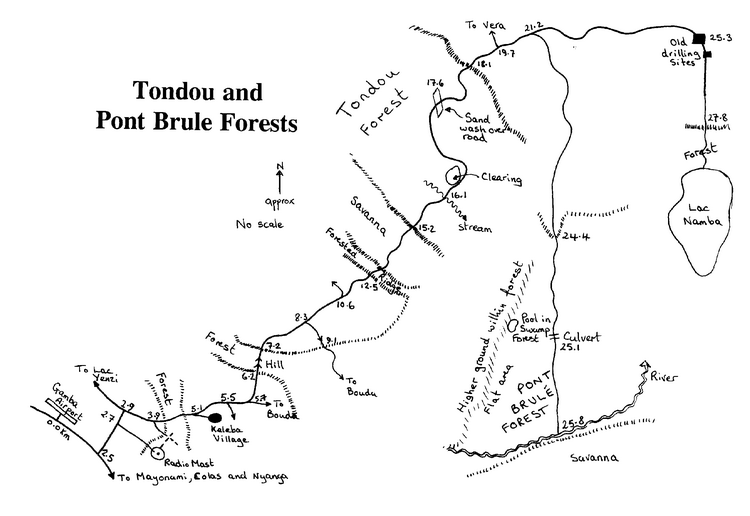
Starting at the airport, head south along the tarmacked road for 2.5 kilometres, and turn left onto a laterite road. At the T-junction at 2.9 kilometres turn right (left will take you on a complete circuit of Lake Yenzi). The grass track just passed on the right, at 2.7 kilometres, goes to a forest clearing containing the airport navigation beacon, which is not usually good for birds, and Congo Serpent Eagle has been seen there. At 3.9 kilometres, just before entering the first scrub/forest, an indistinct track goes off right, at the end of which an old seismic trail penetrates the forest. Park and walk this short trail, (and another which goes off right about 100 metres along it, leading to the beacon). Other than in the dry season, when the forest is too dry, these short trails are excellent for a variety of greenbuls, including White-bearded Greenbul, Red-tailed Greenbul, and Sjöstedt's Greenbul, as well as Green-tailed Bristlebill and Common Bristlebill, Fire-crested Alethe and Black-capped Illadopsis. Other possibilities are Yellow-bellied Wattle-eye, Olivaceous Flycatcher, and Sjöstedt's Owlet. In the trees around the car, it is sometimes possible to see, or hear, Black-headed Bee-eater, which in the dry season breeds in the adjacent grassland.
Return to the laterite track and continue, keeping left at the village of Keléba. En route you will pass the track to Bouda (8.3 kilometres), and go over a forested ridge (12.5 kilometres). On the right, just before the ridge, where the road starts to rise, you will see a sand washh caused by water erosion. In the dry season, before the grass is burnt, this is often a good spot for Black-chinned Quail-Finch. At 15.2 kilometres the track enters Tondou Forest. Park and walk the whole length of the road through the forest. The most productive stretch is usually the 1,500 metres between the stream at 15.2 kilometres, and another sand washh across the road at 17.6 kilometres. The tall trees by the stream often have Johanna's Sunbird and Yellow-spotted Barbet. Other possibilities are numerous, but Red-headed Malimbe, Western Black-headed Oriole, Yellow-mantled Malimbe, White-naped Weaver (only known Gabon locality), Chestnut-capped Flycatcher, Blue Cuckooshrike, and Shining Drongo are all best found here. Rarer, though regular, are Western Dwarf Hornbill, Olivaceous Flycatcher, Spotted Honeyguide, Lyre-tailed Honeyguide (heard in dry season), and Thick-billed Honeyguide. A number of different species can be found by penetrating the forest and walking along old logging tracks and elephant trails. Try the dryer forest on the left, western, side of the road, entering at the sand wash, and walking back toward the clearing. Fire-crested Alethe, Green-tailed Bristlebill, Black-capped Illadopsis and Red-tailed Greenbul are common, while Blue-headed Wood-Dove, Buff-spotted Woodpecker, White-bearded Greenbul, Eastern Bearded Greenbul, and Woodhouse's Antpecker are all regular. For night birds, start at dusk at the forest edge at 18.1 kilometres. Several pair of Bates' Nightjar occur just inside the forest edge, and can be lured out. For owls, return to the sand washh (17.6 kilometres) and walk the road back toward the clearing. African Wood-Owl and Sjöstedt's Owlet are common. The other owl species appear rare, but may well be commoner than supposed. Akun Eagle-Owl is most likely to be found perched in the dead trees of the clearing.
For Pont Brulé Forest, drive to 21.2 kilometres, and turn right on a sand track. Continue as far as possible until the track peters out at a small river at 25.8 kilometres. Owing to the collapse of the bridge over the river, this track has become less and less used. It may be necessary to walk the last part, as a culvert over a stream at 25.1 kilometres is likely to drop out in the near future. The forest here is seasonally swampy, and being lower and wetter than Tondou, supports different species. At the culvert at 25.1 kilometres, enter the forest on the western side of the track, and work the flat area westward and southward. The whole area is a mosaic of elephant and buffalo tracks, and very easy to walk in. The swampy pool, about 300 metres northwest from the culvert may be difficult to find, but is a regular spot for Hartlaub's Duck. This is also the best area for the rare Olive Ibis, which is best looked for between the culvert and pool, though absolute silence and stealth are required to get more than a fleeting glimpse. Black Guineafowl are regular in the area, occurring most often just a few metres in from the edge of the track. Surprisingly, they are not particularly shy birds, and although like to stay out of view, do not generally run off when discovered. Pont Brulé Forest is particularly good for kingfishers with White-bellied Kingfisher, African Dwarf Kingfisher, and Chocolate-backed Kingfisher all found here. Other important species to look for include Forest Francolin, Olive-backed Forest Robin (fairly common), Sjöstedt's Greenbul, Red-tailed Ant-Thrush, White-tailed Ant-Thrush, and Brown-chested Alethe.
Having covered both Tondou and Pont Brulé, return to the main laterite track and continue across the open grasslands as far as Lac Namba at 27.8 kilometres. Cassin's Flycatcher and White-throated Blue-Swallow are usually perched on the dead twigs at the lake edge. At dusk, African Marsh-Owl and Swamp Nightjar occur around the old drilling sites at 25.3 kilometres.
Species known from Tondou (T) and Pont Brulé (P) Forests
Hartlaub's Duck o (P) |
Rufous-sided Broadbill r (P) |
Gamba 2. Nyanga and Colas. These two areas of beach-scrub are good for Loango Weaver, Violet-tailed Sunbird, Gabon Boubou, Sooty Boubou and Snowy-headed Robin-Chat. Unfortunately the Red-tailed Palm-Thrush is not yet known from either. Start with Nyanga, the better of the two, which should have numerous terns and African Skimmer resting on the spit across from the river mouth. Grey Pratincole is common from late October to March.
|
From the airport, drive south along the tarmacked road for 19.5 kilometres and turn off left on a short laterite track. As Nyanga is a popular weekend fishing spot, this track is well used, and although it branches often, it only goes to Nyanga. The drainage ditch at 21.7 kilometres can be worth an inspection, especially in the dry season when the permanent water attracts birds. In the wet season, check the flooded bushes around 27.5 kilometres, when they often hold Violet-tailed Sunbird. At 28.5 kilometres you hit the beach track, the first 100 metres of which is very soft sand in the dry season - be careful not to get stuck. Colas (pronounced 'Co-lass') is approached by turning off the coast road at 15.1 kilometres, where a short stretch of laterite leads to the beach. Loango Weaver can sometimes be found in the scrub here, but it is better to drive down the beach to 18.7 kilometres where a large beach hut sits hidden in the trees next to a series of small lagoons. At least one pair of Loango Weavers have nested in the bushes, 50 metres north of the hut, for the past four years. This is also a spot for Violet-tailed Sunbird (watch the trees across the lagoon), and Gabon Boubou is common. To try for White-crested Tiger-Bittern, take the track at 16.8 kilometres off the main road, and continue for a couple of kilometres to the beach. They occur in low densities in the flooded scrub of the inlet that flows here. It is extremely difficult to find a clear route in the scrub, but just keep trying around the edge of the swamp hoping to flush one. |
Species known from Nyanga and Colas:
Little Grebe r |
Giant Kingfisher c |
Gamba 3. Rembo N'Dogo
Rembo, is a local term, loosely referring to a small river. The Rembo N'Dogo is a long tributary of the N'Dogo Lagoon, about 25 metres in width, bordered by swamp forest and with only a couple of small fishing villages along its bank. Due to minimal disturbance, this is one of the best birding trips from Gamba. For those prepared to do this river trip, two nights, three days on the river should guarantee White-backed Night-Heron and Vermiculated Fishing Owl. The best time is June to September, when the water level is low and the sand-bars on which the night-herons feed, are exposed. The whole area teems with wild animals.
Pirogues (motorised canoes), boatman and supplies can be found in Gamba town, which sits on the edge of the lagoon. From Gamba it is only two to three hours to the mouth of the river, which is navigable for 100 kilometres, as far as Bongo village. However, from a birding point of view it is only necessary to go as far as Lac Kivoro, a few hours up-stream. Once on the Rembo N'Dogo, the first couple of kilometres are mainly swamp palms. Thereafter, both banks are bordered with various forest types. Simply stop the boat and explore. Tracks away from the river can usually be found starting from old habitation which is occasionally passed. The best camping site is on the right, east, side about two thirds of the way toward Lac Kivoro. Tell the boatman you want to camp at the old embarcadère. This sizeable cleared area is the start of an old logging road, which runs east and can easily be walked. However, do not spend hours along it, as the habitat is only secondary growth. Scaly Francolin can be found in the scrub around the campsite and Vermiculated Fishing Owl occurs in the trees around the campsite. For the White-backed Night-Heron, which is completely nocturnal, take the boat up-river after dark and spotlight any exposed sand. Lac Kivoro shrinks markedly during the dry season, when rich lush grass growing on the banks, attracts numerous elephant and buffalo. Check the stunted bushes around the lake for Green-throated Sunbird, a very local species in Gabon. Other species which can be found in forest along the river include Blue-headed Crested Flycatcher and Crested Malimbe.
Species of note from the Rembo N'Dogo:
Great White Pelican r |
Blue Cuckooshrike o |
Gamba 4. Lake Yenzi West (LYW)
See Gamba and Yenzi Areas map. This is a completely degraded, hacked-over area of forest, containing dumped rubbish, plantations and suffering disturbance. However, as it is one of the few pieces of such habitat in the area it holds some surprisingly good birds.
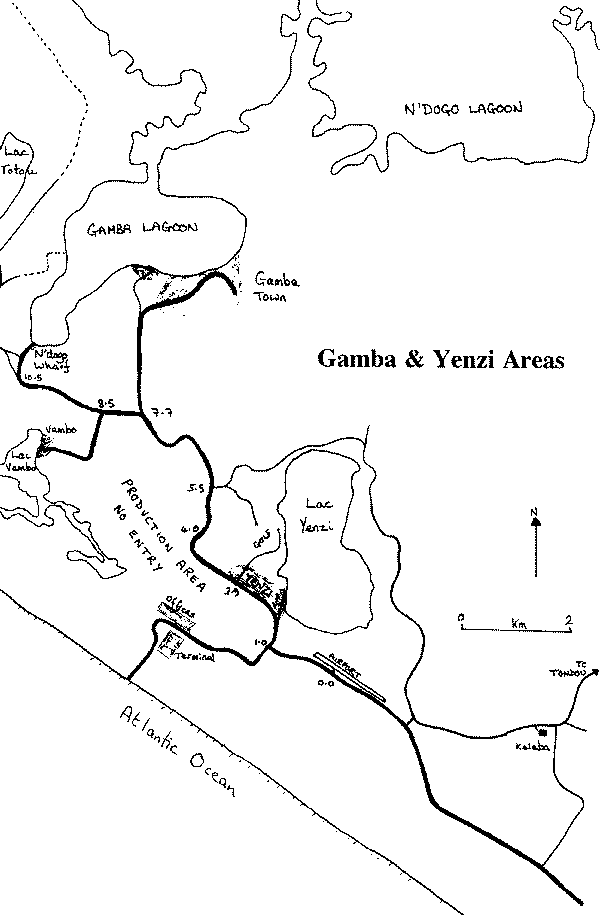
From the airport, follow the map toward Gamba town. En route you cross a road culvert at 4.0 kilometres, which can have Vermiculated Fishing Owl, and which occasionally calls from the swamp palm trees after dark. During the dry season, White-backed Night-Heron can occasionally be seen feeding on the exposed sand by the culvert. However, in late 1992 local people started washing there, and the soap has probably killed off much of the food supply. At 5.5 kilometres turn right onto a dirt track and cross a very small stream at 5.7 kilometres, after which the track immediately forks (fork A). Take the left hand fork, which again forks (fork B) after a further 100 metres or so. Keep right, which is the main track around the north end of Lake Yenzi. The track is drivable, but walking is better. This is the only place in the Gamba area where Velvet-mantled Drongo occurs, but it is not common. Black-bellied Seedcracker and Western Bluebill are both found in rank grass alongside the track.
This is also the best site in Gabon to find Narrow-tailed Starling. There is only one group of 20 or so birds, but they always stay near their 'colonial' tree, which they share with Naked-faced Barbet and Bristle-nosed Barbet. As annual felling and burning creates new dead trees, this site varies. From 1989-1991 the colony was near fork B. However, during 1992 it moved to the other side of the lake, 500 metres south of where the track turns to the south, at the northeastern corner of the lake. Careful attention to the numerous Naked-faced Barbet, may reveal Bristle-nosed Barbet.
Return to fork B and take the other, left hand, fork. After crossing the plain, about 600 metres, check the tall trees and plantation edge where the track disappears into the forest. This is a good spot for Violet-backed Hyliota, Golden-crowned Woodpecker, Green-throated Sunbird and Velvet-mantled Drongo. Return to fork A and take the right hand fork - the track to the golf course. After 200 metres, scan the tops of the tall trees on the right. They are a regular place for the uncommon Purple-throated Cuckooshrike, though knowing the call, a whistled 'Seee-ooo', helps considerably. Any of the dead trees between here and the end of the track can hold Gabon Woodpecker. Black-bellied Seedcracker and Western Bluebill are similarly common. Simple Greenbul is common in plantations near the golf course, where the track changes to a footpath. During the wet season from November to April, African Crake can be seen commonly at dusk feeding in puddles on the track between forks A and B.
Species of note from Lake Yenzi West:
African Cuckoo-Falcon r |
Velvet-mantled Drongo o |
Gamba 5. Bibonga and Bouda Forests
From the airport, follow the Tondou Forest map as far as 8.3 kilometres. Turn right here, and continue along the forest edge to 9.1 kilometres, where you enter the forest. The next 3 kilometre stretch of forest, known as Mossomala, has good species, but is often quiet.
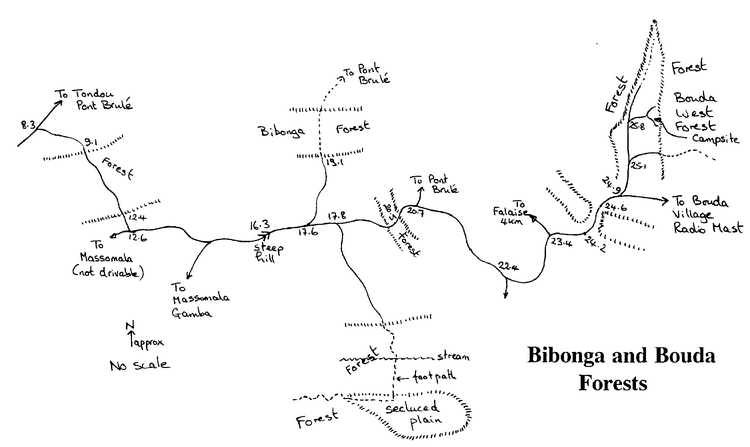
Both Lyre-tailed Honeyguide and Plumed Guineafowl occur, together with all the usual forest greenbuls including Sjöstedt's Greenbul and Ansorge's Greenbul (very rare). Blue-headed Dove is exceptionally common here, and will flush from the track as you drive down it. At 12.6 kilometres, after emerging from the forest, an old track goes off right - ignore it. The plains here hold Black-rumped Buttonquail, which sometimes flush from the track as you drive. At 16.3 kilometres you descend a very steep hill. Be careful of the flat area at the bottom if it has standing water, as it is a good place to get stuck. At 17.6 kilometres an indistinct track branches left to 19.1 kilometres where it enters Bibonga Forest. Park and walk the track - about 700 metres in length. This is a good for both Red-tailed Ant-Thrush and White-tailed Ant-Thrush, Brown-chested Alethe, Yellow Longbill and Olive-backed Forest Robin. The forest on the eastern side of the track is dryer and easier to walk through.
Return to the main track and continue as far as 24.9 kilometres, where another indistinct track goes off left following the forest edge. All along this track you have a good view over the forest to the east, with possibilities of Cassin's Hawk-Eagle and Crowned Hawk-Eagle. However, inside this forest is more interesting with Black Guineafowl, Plumed Guineafowl, and Forest Francolin all possible. Two principle accesses into the forest can be found. Firstly, try the track branching off at 25.1 kilometres which leads to an old logging track which can be followed on foot. The first part of this track is open, and good for Black-headed Bee-eater. Secondly, continue to 25.8 kilometres, and turn steeply down hill. At the bottom you will see a great campsite - the only level ground in a natural hollow. The forest edge here is the only place for Pale-olive Greenbul, and plenty of elephant tracks penetrate the forest. Species of note are listed below. Other species are similar to those recorded in Tondou and Pont Brulé Forests.
For those with more time, it is possible to return to the main track and continue to the village of Bouda - a farther 23 kilometres - on the shore of Lake Cachimba. The track firstly crosses plains, then more than 10 kilometres of fairly good, though open forest, which is exceptionally good for Black-headed Bee-eater.
Species of note from Bibonga and Bouda West Forest
Red-necked Buzzard o |
Yellow-spotted Barbet o |
Section 1 - Introduction, logistics, itinerary and general information.
Section 2 - Birding sites (part 1).
Section 3 - Birding sites (part 2).
Section 4 - Birding sites (part 3).
Section 5 - Annotated checklist with identification notes (non-passerines).
Section 6 - Annotated checklist with identification notes (passerines).

